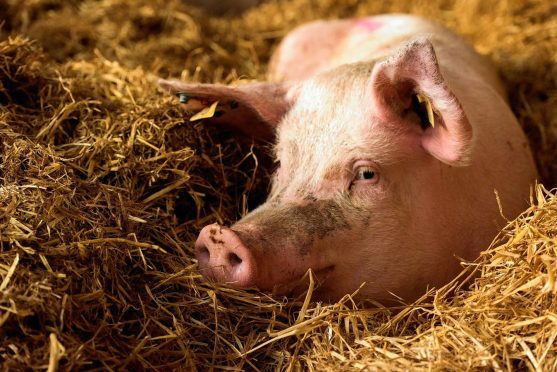The host of Scotland’s new pig monitor farm is confident that, despite the vagaries of the pig market, there are many opportunities for the sector.
Patrick Stephen, whose farming business is based at Conglass near Inverurie, said there are many advantages to farming pigs in Scotland.
“Scotland has a lot going for it with regards pigs. We have a decent enough climate which allows us to grow plenty of grain for use as feed and now we have a pig processing facility close at hand.”
He added: “Farmers can have a tendency towards doom and gloom but pigs have been good for us and when prices are right they can make money quicker than any other enterprise.”
Mr Stephen is a director of Quality Pork Ltd, (QPL) which runs the new pig abattoir at Brechin. He is also chairman of Huntly-based pig supply co-operative Scottish Pig Producers (SPP).
“I have always been keen to play my part in the Scottish pig industry and that is one of the reasons I was happy to support the monitor farm initiative,” he said.
The plan is to have five meetings each year over the four-year life of the project. For biosecurity reasons, it makes sense to hold the meetings off-farm and Mr Stephen expects to use video as a means of demonstrating on-farm practice to the group. The facilitators are specialist pig vet Grace Webster and George Chalmers of SAC Consulting, part of SRUC, Scotland’s Rural College.
The project is jointly funded by Quality Meat Scotland (QMS) and Opportunity North East (One), a private sector economic development company that aims to broaden and strengthen the regional economy through sector initiatives in food, drink and agriculture; life sciences, oil and gas; and tourism. One is backed by an investment of £25million over five years from the Wood Foundation.
Mr Stephen’s pig unit is based at Mill of Carden, Pitcaple, around four miles from Conglass and is run by unit manager Wayne Ducker and a staff of three. They look after 530 sows with all progeny finished on the site, with the exception of around 600 weaners which go out to straw yards on a “bed and breakfast” basis weighing around 40 kilograms.
Finished pigs, at between 110 and 115 kilograms liveweight, go through SPP to either QPL at Brechin or Woodhead Bros at Colne in Lancashire.
The enterprise was originally run as a multiplier unit producing high grade gilts in recent years it has been focussed on producing carcase pigs. The female line is JSR Genepacker 90 with JSR 900 or Danbred Duroc used as terminal sires using AI.
Mr Stephen’s priority is to better understand growing performance. “I think we could get better at monitoring growth. Apart from anything else we have two feed systems, ad-lib and restricted feeding, and I would like to know which performs best. It will also be interesting to find out whether daily growth rate is more important than feed conversion ratio,” he added.
All feed used on the unit is home-mixed. Mr Stephen grows 365 hectares of cereals including 110 hectares on contract and 100 hectares of grazed forage. Protein and minerals are bought-in and batches of feed prepared as required using a Norvite mobile mill and mixer. Some by-products – mainly brewers’ yeasts – are fed to the finishing pigs.
The sows are housed on straw and fed using electronic sow feeders (ESFs). Piglets are weaned into nursery units and are provided with wet feed.
Mr Stephen is looking forward to trying out some new technology as part of the monitor farm project. For example, he has just returned from the giant animal husbandry exhibition EuroTier in Hanover where he was impressed by a device, the size of a mobile phone, which could calculate the weight of a pig simply by scanning it remotely. Apart from speed, using such a device would completely remove any possible stress associated with weighing in a conventional crate.
Pigs have been kept at Mill of Carden since the 1960s, with the original herd of 40 sows growing steadily to present numbers.
Mr Stephen said: “We have invested steadily in buildings and equipment as the sow numbers have increased and that has helped keep us up-to-date.” The most recent new building is a French-designed weaner shed which was put up 18 months ago and features an innovative ventilation system.
Allan Ward, pig specialist with QMS, said: “The farm is a great example of a pig business which is performing well but there is recognition that there is scope for further improvement and that small changes can deliver significant gains.”
Peter Cook, director of food, drink and agriculture at One, said: “The north-east of Scotland is where the majority of Scottish pig farming takes place. To sustain and grow the sector we need to see a significant improvement in performance, which can be gained through the monitor farm programme.
“I’ve known Patrick for many years and I’ve been impressed by his willingness to innovate. As well as technical improvement, we are keen to help producers to look at the marketplace for Scottish pig meat and to strengthen the Brechin facility to underpin the future of the north east pig sector.”
Around 60% of Scotland’s pig herd is concentrated in the north-east with the contribution to the region’s economy put at around £40-£50million annually. But producers from other parts of the country have not been forgotten. The monitor farm project will also involve three separately-funded satellite groups in Dumfries, Perth and Nairn.
